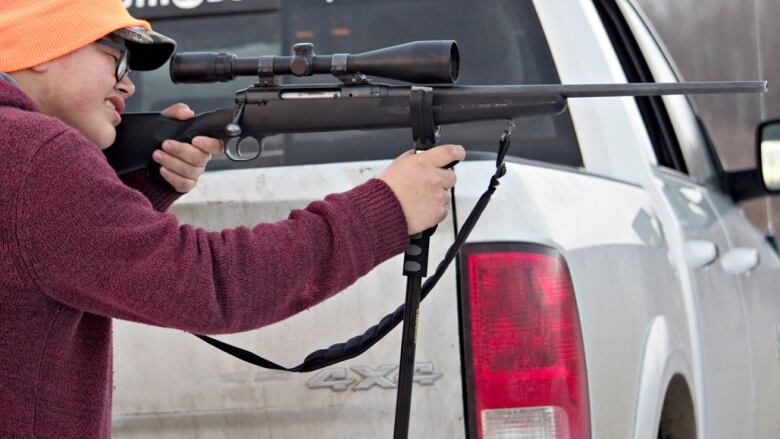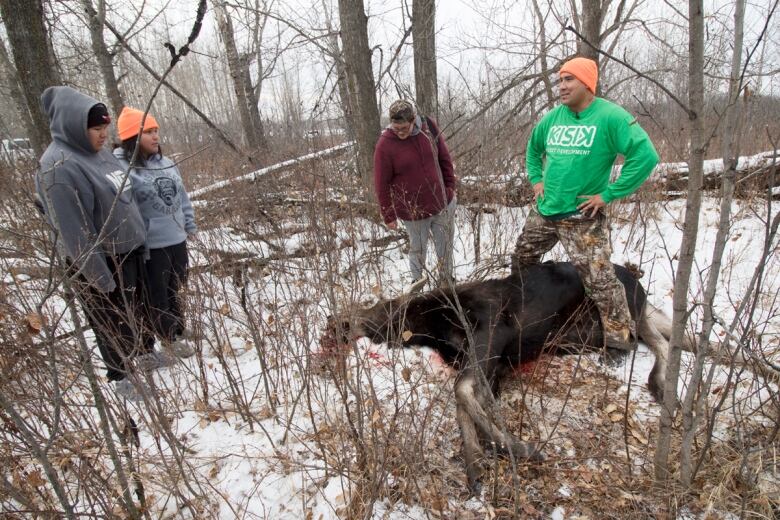From hunt to hide: Indigenous teens take to the woods for class with new land-based education project
Poundmaker First Nation, Sask., students going on hunting, fishing trips

Carson Albert-Checkosis was still tired from an early wake-up call, but what he saw made him spring to life.
On a mid-November morning, the sun was just beginning to light up the shoreline of a large slough in a hunting area about 60 kilometres east of Lloydminster.
As Carlin Nordstrom drove 15-year-old Albert-Checkosis and two classmates into a clearing, a large, dark shape became visible across the frozen water. A cow moose was rooting through the bush, eating her breakfast.
Nordstrom told Albert-Checkosis to prepare his rifle. The excitement in the air was palpable as he loaded and sighted the gun with Nordstrom's help.
The group, which included Shawnee Smallchild and Ariah Baptiste-Cameron, walked around the far end of the water to get as close as possible before taking a shot.
It was 8:30 a.m. on the first day of a four-day hunting trip. Albert-Checkosis had been out hunting once before but had never shot an animal.
Before he was able to take a shot, the moose disappeared in the bush.
"(She) gave us the slip!" said Nordstrom.

Nordstrom leads the Oskayak Minowin Project, which is funded by Health Canada. It's a new land-based healing initiative he started with a group from Poundmaker First Nation, located two hours northwest of Saskatoon.
All of Poundmaker's youth from Grades 7 to 10 went on multi-day hunting and fishing trips this fall, learning how to harvest healthy and sustainable food sources for their community.
"We really want these kids to come away with confidence in being able to skin an animal, process the animal, butcher the animal (and) cooking skills," said Nordstrom, who works with Indigenous youth in a variety of programs.
They'll also take part in empowerment, mental health and wellness workshops.
The hunt is on
The sun was coming up over the treeline, beams shooting through the clouds. There wasn't a hint of wind, the only sound the occasional woodpecker's tapping. It was cool, but not cold in other words, a perfect day for hunting.
Nordstrom drove the group farther around the slough, before taking the students on foot to track the moose.
They eventually found her. Albert-Checkosis quickly readied the rifle and took the shot, his emotions, he later said, a mix of anxiety and eagerness. A loud boom punctuated the morning's stillness, echoing across the prairie.
It was a clean shot through the shoulder, which hit the lungs and put the moose down immediately.

"Wow," Albert-Checkosis said. "That was exciting."
A big smile was plastered on his face, his forehead glistening with sweat.
"I was kinda happy," he said of killing the moose, "but kind of sad a little bit for taking out a life that could probably have lived for so many more years ... But it's meat now."
By 12:30, the moose would be gutted, skinned and quartered, the meat in the truck, the students loaded up to return to the cabin and share the day's stories with elders.

Each participant receives a set of hunting knives. Nordstrom taught everyone how to sharpen their knives before gutting the animal.
What the group doesn't eat will be used for Chief Poundmaker School's lunch program.
Gutting a moose is no simple task "shooting it is the easy part," said Nordstrom.
It takes considerable strength and skill to open the animal's body and to remove the innards without contaminating the meat.
Nordstrom demonstrated the technique he's honed over years of experience, deftly separating the moose's innards from the carcass. Albert-Checkosis helped him remove the heavy mass.
It makes me feel really happy that we can give meat to our community and feed all the kids.- CarsonAlbert-Checkosis
Next, everyone began the lengthy skinning process. Steam erupted into the air. The students' bare hands, which were covered in blood by then, stayed warm thanks to the carcass's lingering heat.
The first smell to hit the nostrils was the metal, iron scent of the blood. It was mixed with excrement, released during the animal's last moments. The innards emitted a raw odour. All combined, it made a primal bouquet.
Once the skinning was finished, Nordstrom showed them how to quarter the animal.
The three students tackled the work without complaints.
Albert-Checkosis hoisted a large leg quarter over his shoulder, smiling proudly as he realized his own strength. He carried it to the waiting truck.
"It makes me feel really happy that we can give meat to our community and feed all the kids."
Lastly, Nordstrom removed the moose's nose nothing is wasted. An elder from English River First Nation, Violet Janvier, will boil it for soup later that night at the cabin. Along with being an assistant cook for the Oskayak Minowin Project, Janvier also teaches the teens traditional hide tanning, cooking and smoking methods.

The project's healing aspects cannot be understated. Nordstrom points to the intergenerational effects of residential schools and other hardships Poundmaker youth have faced.
"It's about getting them out into a new opportunity and experience that they would have never had, and giving them a chance to empower themselves, learn a new skill and be in a positive environment."
Albert-Checkosis's appreciation for Nordstrom and the project is obvious.
"I would really love to do this again. Even though this is our first day, I'd love to come out much more."
For Nordstrom, who has been hunting and fishing since he was a boy, the students' transformational experiences this fall are proof of the project's value.
"Driving down today, thinking about how happy these kids are to be out here and how excited they were, for me to be able to do something that I love and teach these kids these skills and see all the positive results, I'm pretty happy."












_(720p).jpg)


 OFFICIAL HD MUSIC VIDEO.jpg)
.jpg)



























































































